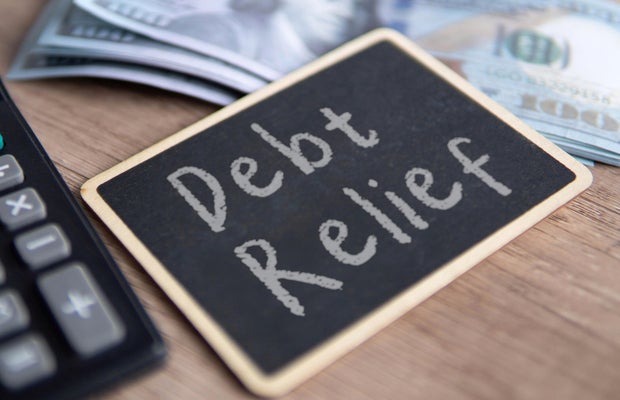Mohd Izzuan/Getty Images
Right now, credit card balances are at record highs, and the interest rates these short-term borrowing tools come with aren’t far off. Americans owe roughly $1.23 trillion in credit card debt, a figure that’s risen sharply alongside persistent inflation and years of high borrowing costs. And, they owe that collective amount at a time when credit card interest rates are averaging around 21%, just under the highest rate on record.
As a result, credit card delinquencies and charge-offs have ticked up over the past year, especially among borrowers with lower credit scores. As more Americans seek ways to escape their high-rate debt, credit card debt forgiveness can be a smart solution to consider. With this type of debt relief, the goal is to work with your creditors to try and settle on a lump-sum payment that’s lower than your current balance. When successful, this approach can result in big savings.
But qualifying for these programs isn’t automatic. Most debt relief companies have specific requirements you must meet to enroll. If you start preparing now, though, you could set yourself up to settle your debt for far less than you owe next year.
Check your credit card debt forgiveness eligibility now.
How to qualify for credit card debt settlement in 2026
If you’re planning to pursue credit card debt forgiveness, here’s what to focus on between now and the start of the new year:
Get a full picture of your debt situation
Before you can qualify for any debt forgiveness program, you’ll need to know exactly what you owe. Gather every credit card statement, take note of your balances, interest rates, and minimum payments and determine the total amount of your unsecured debt. Most debt relief programs require you to have a minimum of $7,500 to $10,000 in unsecured debt to qualify, so understanding your total balance is key.
If you’re juggling several cards with high balances, that might make you a strong candidate for credit card debt forgiveness. However, if your total debt amount is smaller or includes a mix of secured and unsecured accounts, you may need to consider other relief options.
Learn if you qualify to settle your credit card debt for less now.
Review your credit report
Your credit report will also play a role in whether you qualify and how your creditors may respond to settlement offers. So, before enrolling in a debt forgiveness program, take the time to check your report and identify any inaccuracies. Fixing errors now can help you present a clearer, more accurate financial picture when it’s time to enroll in a forgiveness program. And, it can also make it easier to immediately focus on the real issues at hand.
Build up a settlement fund early
Debt forgiveness doesn’t work without cash on hand. Creditors and debt collectors want to be paid quickly after an agreement is reached, so you’ll need to either set aside funds that can be used to make lump-sum offers or set up monthly payments through a structured debt relief program.
Most debt relief companies will require you to make monthly deposits into a dedicated account, and the money that accrues will be used to pay negotiated settlements once creditors agree. If you start building that fund now, you’ll be in a stronger position to negotiate meaningful reductions even earlier next year.
Stop relying on new credit cards
Continuing to rack up new balances on your cards while trying to settle existing ones can disqualify you from some programs. Lenders want to see that you’ve recognized the problem and stopped adding to your debt load, so try shifting to debit or cash-only spending now, and avoid taking out new loans or lines of credit before applying.
This not only demonstrates financial discipline but also helps stabilize your monthly budget. And, having a clear idea of what your budget can handle will be a crucial part of meeting the ongoing requirements of your debt forgiveness plan.
Consider speaking with a debt relief company now
You don’t have to wait until you’re in crisis to start reaching out to debt relief companies about your options. A reputable debt relief company can review your current situation, estimate what your potential settlements might look like and help you determine whether you’ll qualify by 2026. They can also advise on other strategies — like credit counseling or debt consolidation — if those are a better fit.
Understand the tax consequences
If you have debt forgiven through the settlement process, that debt is typically considered taxable income by the Internal Revenue Service (IRS). For example, if you settle a $15,000 debt for $7,500 (or 50% of what’s owed), you may owe taxes on the $7,500 that was forgiven. It’s important to understand how this might affect your situation so there are no surprises come tax season. You may even need to start planning for this additional tax burden now to avoid bigger problems down the road.
The bottom line
If you’re hoping to qualify for credit card debt forgiveness in 2026, the work starts now. Getting organized, putting away money for settlements, cutting off new borrowing and talking with a reputable debt relief company can all dramatically improve your chances of approval — and help you settle your debts for a fraction of what you owe. Debt forgiveness isn’t the right move for everyone, but for borrowers overwhelmed by mounting balances and double-digit interest rates, it can offer a real path to financial recovery.



